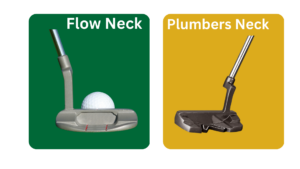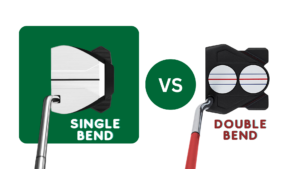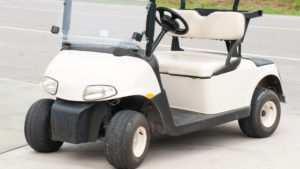Putting is a crucial aspect of golf that requires precision and accuracy. The right putter can make all the difference when it comes to sinking putts and lowering your score. One important decision that golfers have to make when choosing a putter is whether to go for a milled putter or an insert putter. Both types of putters have their unique features and benefits, and understanding the differences between them can help you make an informed decision about which one is right for you.
In this blog post, we’ll compare milled and insert putters in terms of their performance capabilities and maintenance requirements. We’ll look at how each type performs in different conditions, what kind of care they require, and provide our final thoughts on choosing between a milled vs insert putter. So let’s dive into it.

Table of Contents:
- Milled Putters
- Benefits of a Milled Putter:
- Accuracy and Distance Control
- Consistency in performance
- Durability and longevity
- Drawbacks of a milled putter
- Higher Cost
- Less Forgiving on Mishits
- Limited Customization Options
- Benefits of a Milled Putter:
- Insert Putters
- Benefits of an Insert Putter
- Increased Forgiveness on Mishits
- Enhanced Feel and Sound
- Wider Range of Customization Options
- Drawbacks of Insert Putter
- Inconsistent Performance
- Reduced Durability and Longevity
- Possible Loss of Feel and Feedback
- Benefits of an Insert Putter
- Performance Comparison
- Accuracy and Distance Control:
- Feel and Feedback:
- Forgiveness on Mishits
- Customization Options
- Durability and Longevity
- Maintenance Considerations
- Cleaning and Care for Milled Putters:
- Cleaning and Care for Insert Putters:
- FAQs in Relation to Milled Putter vs Insert
- Conclusion
Milled Putters
Milled Putters are a type of golf club that has been machined from solid blocks of metal. The process creates an incredibly precise, consistent putter with a perfectly smooth face and striking grooves. Milled putters offer many benefits over traditional cast or insert putters, including improved accuracy and distance control, enhanced feel and feedback, as well as greater durability.
Usually, it is crafted by cutting away material from the head to create its shape out of one single block of metal. This allows for extremely tight tolerances in manufacturing which results in more consistent performance than traditional casting methods can provide. Additionally, this method allows for intricate designs on the sole and face that cannot be achieved through casting alone.

Benefits of a Milled Putter:
Accuracy and Distance Control
With tighter tolerances comes better consistency which translates into more accurate shots across all distances. Furthermore, due to their precision design, milled putters allow you to precisely adjust your launch angle resulting in even better control over your ball flight trajectory when compared to other types of clubs such as a milled blade putter or mallet-style putter.
Consistency in performance
Milled putters provide a consistent feel throughout the stroke, as there is no difference between body weighting and face weighting due to them being machined from one piece of metal.
This results in excellent feedback off each shot, with no discrepancies compared to other styles such as inserts or blades where different parts may have varying weights which can lead to an inconsistent feel during swings. Furthermore, their precise design allows for more accurate shots across all distances and the ability to adjust launch angle precisely for even better control over ball flight trajectory.
Durability and longevity
Milled putters offer remarkable durability due to their construction from a single block of metal, making them the go-to choice for golfers seeking long-term reliability. Their precision engineering ensures consistent performance and provides unparalleled feedback off each shot compared to other styles such as inserts or blades where different parts may have varying weights which can lead to an inconsistent feel during swings.
Furthermore, their precise design allows for more accurate shots across all distances and the ability to adjust launch angle precisely for even better control over ball flight trajectory.
Drawbacks of a milled putter
Higher Cost
One of the main drawbacks of using a fully milled putter is that they tend to be more expensive than other types of putters. This is due to the precise manufacturing process used to create milled putters, which involves using a CNC machine to carve the putter head from a solid block of metal. This process is time-consuming and requires high-quality materials, such as carbon steel or stainless steel, which further adds to the cost of the putter.
Less Forgiving on Mishits
Milled putters are less forgiving on mishits than other types of putters. This is because milled putters have a smaller sweet spot compared to insert putters, which are designed with a softer insert material in the face that provides more forgiveness on off-center hits. When a golfer hits a ball with a milled putter outside of the sweet spot, the ball may not roll as consistently or travel the expected distance. This can result in inconsistent ball roll and distance control, especially for golfers who struggle with consistent ball striking.
Limited Customization Options
While some milled putters may have adjustable weights or different face patterns, the customization options are generally more limited than insert putters. This can be a drawback for golfers who are looking for a putter that matches their specific stroke or playing conditions. For example, a golfer may prefer a putter with a certain amount of toe hang or a specific alignment aid. With milled putters, these options may be more limited, and the golfer may have to adjust their stroke to match the putter.
Among the best-milled putters in the market, Scotty Cameron is one of the best. It will offer you a great combination of feel and accuracy, making them an excellent choice for experienced golfers. On the other hand, insert putters provide increased forgiveness and distance control which makes them ideal for new players who are still learning the game.
Insert Putters
An insert putter is a type of golf club that features a metal or plastic face plate with an insert in the center. The insert employed in the insert putter is usually crafted from soft elements, such as urethane, rubber, or TPE (thermoplastic elastomer). This design helps to reduce vibration and provide better feedback on contact with the golf ball. It also increases spin for improved accuracy and distance control.

Benefits of an Insert Putter
Increased Forgiveness on Mishits
One of the main benefits of using an insert putter is that it provides increased forgiveness on mishits compared to milled putters. The softer insert material is designed to absorb more of the impact energy from off-center hits, reducing the amount of energy that is lost and resulting in less distance loss and improved accuracy. This can be especially helpful for beginner and intermediate golfers who may struggle with hitting the sweet spot consistently.
Enhanced Feel and Sound
Another benefit of using an insert putter is that it can provide enhanced feel and sound on impact compared to milled putters. The softer insert material can provide a more muted and satisfying “click” sound on contact, which can help golfers judge the quality of their stroke and the distance and speed of their putts. Additionally, the softer feel can provide a more comfortable and responsive sensation for golfers who prefer a softer feel on their putts.
Wider Range of Customization Options
Insert putters offer a wider range of customization options compared to milled putters. This is because the insert material can be easily replaced or modified to suit the golfer’s preferences.
Golfers can choose from a variety of insert materials with different levels of hardness and responsiveness, allowing them to fine-tune their putter to match their stroke and playing conditions. Additionally, insert putters often come in a variety of head shapes and sizes, providing golfers with a greater range of options to choose from.
Drawbacks of Insert Putter
Inconsistent Performance
One of the main drawbacks of using an insert putter is that it may not provide consistent performance compared to milled putters. This is because the insert material, which is often made of softer materials like polymer or elastomer, can compress or wear down over time.
As a result, the putter face may become less responsive or “dead,” resulting in inconsistent ball speed and distance control. Additionally, the softer insert material may not provide the same level of consistency on off-center hits as milled putters, leading to less accurate putts.
Reduced Durability and Longevity
Insert putters are generally less durable than milled putters, which are typically made from high-quality materials like carbon steel or stainless steel. The insert material can wear down or become damaged over time, especially with frequent use. Additionally, the insert material may become dislodged or detached from the putter face, which can affect the putter’s performance and require costly repairs or replacement.
Possible Loss of Feel and Feedback
Another drawback of using an insert putter is that it may not provide the same level of feel and feedback as milled putters. While the insert material can provide a softer feel on impact, it may also reduce the golfer’s ability to sense the ball’s roll and distance.
This can affect the golfer’s ability to adjust their stroke and improve their putting accuracy. Additionally, the softer feel can make it difficult for some golfers to judge the distance and speed of their putts, especially on longer putts.
Insert putters are a great option for golfers looking to improve their accuracy and distance control. However, a performance comparison is key when considering the right type of putter for your game.
Performance Comparison

Accuracy and Distance Control:
Milled putters are known for their consistency in performance. They are milled from a single block of metal, which ensures that the weight and balance of the putter remain consistent throughout the club. This consistency can help golfers develop a consistent stroke and improve their overall putting performance. Using a milled face putter it is easier to hit the golf ball harder.
Insert putters, on the other hand, can vary in performance depending on the type of insert used. Some inserts may enhance the feel and feedback of the putter, while others may affect the ball’s roll or distance control.
Feel and Feedback:
Insert putters usually provide a softer feel than milled putters because of the material used in their construction. Many players prefer this softer feel as it provides feedback on where they’ve struck the ball without being too harsh or jarring on impact.
Milled putters tend to offer a firmer feel with more feedback so players can better gauge how hard they’re hitting their shots.
Forgiveness on Mishits
One of the main advantages of insert putters is their forgiveness on mishits. The use of inserts can help reduce the negative effects of off-center hits, which can result in a more consistent ball roll and distance control.
Inserts can also provide more weight distribution, which can increase the moment of inertia (MOI) of the putter. A higher MOI can reduce the putter’s twisting on off-center hits and improve the consistency of the ball’s roll. This forgiveness can be especially beneficial for golfers who struggle with consistent ball striking or who have a tendency to miss the center of the putter face.
Milled putters, on the other hand, are less forgiving on mishits. Because milled putters are made from a solid block of metal, any off-center hits can result in inconsistent ball roll and distance control. However, some golfers may prefer the feedback and consistency of milled putters, even if they require more precise ball striking.
Customization Options
Insert putters offer a wider range of customization options compared to milled putters. The use of inserts allows golfers to change the feel and roll of the putter by swapping out inserts. Inserts can be made from a variety of materials, such as rubber, plastic, or metal, and each material can affect the putter’s feel and roll. Some inserts are designed to provide more feedback, while others can increase the ball’s forward spin or reduce skid.
Milled putters, on the other hand, are limited in customization options due to their solid construction. While some milled putters may have adjustable weights or different face patterns, the options are generally more limited than insert putters. However, some golfers may prefer the simplicity and consistency of a milled putter over the added customization options of an insert putter.
Durability and Longevity
Milled putters are known for their durability and longevity. The solid construction and use of high-quality materials make them less prone to wear and tear over time. Milled putters are often made from softer metals, such as carbon steel or stainless steel, that are designed to develop a natural patina over time. This patina can add to the putter’s character and can actually improve the putter’s feel and feedback.
Insert putters, on the other hand, may require more maintenance and replacement of inserts over time. The inserts can wear out or become loose, which can affect the putter’s feel and roll. Inserts can also be damaged by harsh playing conditions, such as sand or dirt in the putting surface. However, insert putters are often made from durable materials, such as aluminum or titanium, that can withstand the wear and tear of regular play.
Both types of putter are designed to last many rounds before needing replacement but there are some differences between them when it comes to durability. Inserts may wear out faster due to friction caused by contact with other clubs during play while milled faces typically hold up longer since they’re made from solid metal blocks that don’t experience much wear and tear during use.
Overall, the performance of milled putters and insert putters can vary greatly depending on personal preference. Yet, when selecting between these two putter designs, one should also contemplate upkeep matters.
Maintenance Considerations

Cleaning and Care for Milled Putters:
Maintaining a milled putter is relatively easy, but it requires the right tools. Cleanse the putter head of any dirt or grime with a gentle soap and water blend, then make sure to dry it off fully. You should also be sure to dry it thoroughly after cleaning.
Additionally, you can use a soft cloth or brush with an approved cleaner such as WD-40 to help remove any rust spots or oxidation from your clubhead. Finally, if your putter has grooves in the faceplate, make sure they are kept free of debris by using a stiff brush and approved solvent.
Cleaning and Care for Insert Putters:
Insert putters require more maintenance than milled ones since they are made from softer materials like aluminum alloy or brass which can easily become scratched over time. To keep them looking their best, start by wiping down the insert with a damp cloth every few weeks so that no dirt builds up on its surface.
If there is buildup present already then use an appropriate cleaner such as rubbing alcohol to get rid of it without damaging the material underneath. Additionally, check for any loose screws periodically and tighten them when needed; this will ensure maximum performance during playtime.
Maintaining your putter is an important part of keeping it in top condition, so be sure to consider the differences between milled and insert putters when making a decision. Considering the maintenance factors, let’s now assess which putter type is ideal for you.
FAQs in Relation to Milled Putter vs Insert
Do milled putters make a difference?
Milled putters can make a difference in the game of golf. Milled putters are made with precision, providing a more consistent roll and improved accuracy on the green. The milling process also allows for customizations to be made to each individual club head, such as weight distribution or alignment markings.
This customization helps players achieve better results from their putting stroke by increasing feel and control over the ball’s trajectory. Ultimately, milled putters offer an advantage that can help lower scores on the course.
Is a milled putter face better?
Milled putter faces offer a number of advantages over traditional cast putters. The precision and accuracy offered by deep milling can provide golfers with more consistent results when striking the golf ball, resulting in improved performance on the green.
Milled putters tend to be heavier than their counterparts, allowing for greater control and better feel at impact. Ultimately, whether or not a milled face is better depends on personal preference; however, most experienced players will benefit from using one due to its superior craftsmanship and performance capabilities.
Conclusion
Milled putters and insert putters both offer golfers a range of performance benefits. Milled putters provide greater accuracy due to their precision construction, while insert putters can be more forgiving for those who struggle with consistency.
Maintenance is also an important consideration when deciding between the two types of clubs; milled models require frequent cleaning and care whereas inserts are less demanding in terms of upkeep. It ultimately comes down to personal preference, as the two types offer different benefits depending on one’s style and skill level – thus taking some time researching before choosing is wise. But if you want to hear from us then we prefer milled putter compared with an Insert putter.
Discover the difference between milled putters and insert putters with GolfingEagle.com! Learn expert tips on how to choose the right type of putter for your game today.






